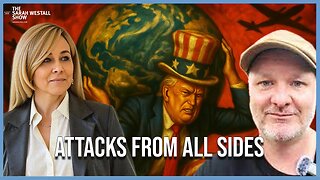Premium Only Content

Episode 982 Reasons for the Catholic Church Condemning Freemasonry - Part 3
In the early half of the 19 Century secret papers of the the Alta Vendita – the highest lodge of an Italian secret society with ties to Freemasonry, called the Carbonari – were uncovered by Pope Gregory XVI.
Those papers were subsequently published at the request of Pope Gregory’s successor – Pope Pius IX, who guaranteed the authenticity of these documents.
His successor, Pope Leo XIII, in the late 1800s was presented with a copy of a book that contained the full text of the documents written by the Alta Vendita.
The documents are called The Permanent Instruction of the Alta Vendita, which is the title of the enclosed book that we are pleased to be able to send to you.
The secret documents of the Alta Vendita outline the plot of these enemies of Christ to infiltrate and defeat the Catholic Church from within.
The plans were formulated once the enemies of the Church realized that they would never succeed in completely destroying the Church. Their alternative was to remove the influence of the Church in society, while simultaneously using the Church to further its own demonic anti-Christ agenda.
Successive popes, beginning in the late 18 Century and the through the reign of Pius XII (1939-1958), continually warned the Catholic faithful about the evils of freemasonry.
During the pontificate of John Paul II. It was evident then, that the freemasons had succeeded in their plans to infiltrate the Church with a pope leading the Church on the plotted path of “renewal” – or in the case of John Paul II, “a new springtime”. That is, a pope whose pontificate was allowing the promotion of liberal Catholic ideas.
Although in comparison to the current Pope (Francis), John Paul II seems tame. Nonetheless, a lot of the groundwork for what is happening today was laid and accomplished during John Paul II’s pontificate and the two pontificates preceding his – Paul VI with his introduction of the Novus Ordo Missae and John XXIII
with the Second Vatican Council, which opened the door for these enemies.
This is why in these episode I show why the popes have have warned repeatedly for centuries about the evils of Freemasonry.
Before we start this episode I want to list the times the Free Masons were made public”
1. President Moreno of Ecuador
2. Christeros of Mexico
3. Our Lady of Fatima
García Moreno, following his third election victory in 1875, wrote immediately to Pope Pius IX asking for his blessing before inauguration day on 30 August:
“I wish to obtain your blessing before that day, so that I may have the strength and light which I need so much in order to be unto the end a faithful son of our Redeemer, and a loyal and obedient servant of His Infallible Vicar. Now that the Masonic Lodges of the neighboring countries, instigated by Germany, are vomiting against me all sorts of atrocious insults and horrible calumnies, now that the Lodges are secretly arranging for my assassination, I have more need than ever of the divine protection so that I may live and die in defense of our holy religion and the beloved republic which I am called once more to rule.”
Preseident García Moreno's On 5 August, shortly before his assassination, a priest visited García Moreno and warned him, "You have been warned that your death was decreed by the Freemasons; but you have not been told when. I have just heard that the assassins are going to try and carry out their plot at once. For God's sake, take your measures accordingly!" García Moreno replied that he had already received similar warnings and after calm reflection concluded that the only measure he could take was to prepare himself to appear before God.
Criteros
The Mexican Catholics 70 years ago, rose up against Freemasonry for the social reign of our Lord Jesus Christ. They were called the Cristeros.
A Century of Religious Persecutions
From the time its independence was declared in 1821, Mexico had a troubled history: civil wars, dictatorships, coup d’états, revolutions (1876-1911)....Maximilian's Empire (1863-67) was but a brief and very imperfect4 parentheses in the persecutions endured by the Church once the Spanish left: property despoiled, priests imprisoned, assassinations plotted, bishops expelled....Why so many misfortunes? A proverb provides the answer: "Poor Mexico! so far from God and so close to the United States..." The United States did not want a great Catholic power at their door. At the time of Mexican independence, they worried about this potential rival whose land mass roughly equaled their own, and whose population, though less numerous (6.5 millions of inhabitants versus 9.5 millions) had become, thanks to a very lively Catholic faith, a true nation, while the United States remained, and remains even now, the "Salad Bowl."5
In the 1830's, war broke out. Betrayed by Masonic generals,6 Mexico lost its northern territory, California, Texas, New Mexico (1848), and was placed under United States political and economic hegemony.7
The puppets successively made presidents of Mexico were all corrupt Masons who immediately enforced the orders issued from Washington to "defanaticize" the country, that is, to destroy its Catholicism which dated from the 16th century when the Spanish (especially the Franciscans8), had evangelized Mexico; the order also demanded defiling the memory of its European heritage by exalting the pre-Columbian era9 and the "marvelous" Aztec civilization where the wheel and the vault were unknown, but where slavery, human sacrifice and cannibalism were practiced on a grand scale even in the 16th century!10
Here are just two examples of this policy: The first official act of President Juarez was to transform St. Francis of Mexico Church into a Protestant temple (1867),11 and the publication of Pope Leo XIII's encyclical Humanum Genus (1884) was prohibited (it condemns Freemasonry) even in the seminaries!12
In 1914, President Carranza, put in place by the US, inaugurated a period of open persecution: priests were massacred (160 were killed in Mexico in February, 1915). John Lind, one of Woodrow Wilson's advisors, rejoiced over the news: "Great news! The more priests they kill in Mexico, the happier I shall be!" An American pastor, indignant about the outraging of the nuns in Vera Cruz, received this reply from Wilson's personal representative: "After prostitution, the worst thing in Mexico is the Catholic Church. Both must disappear!
In 1924, Plutarco Elias Calles became President. For this descendant of Spanish Jews, a 33rd degree Mason, "the Church is the unique cause of all Mexico's misfortunes." For him, too, she had to disappear. With the complicity of a Masonic priest, Fr. Perez, proclaimed by the government "Patriarch of the Mexican Catholic Church," Calles founded a schismatic "patriotic Church," as the Communists were to do later in China. The wine used in the Mass was replaced by mescal. But the maneuver was met with widespread contempt. The government could finance the opening of 200 Protestant schools and Calles could smooth the way for heretical sects (already well financed by the US), but the Mexican people remained stubbornly attached to Rome!
In 1926, the president and his clique launched a new offensive which they hoped to be definitive: "Now there must be a psychological revolution," Calles declared. "We must penetrate and take hold of the minds of the children and the youth because they must belong to the revolution." The Catholic schools were shut down, the congregations expelled, Christian trade unions forbidden, numerous churches confiscated and profaned (turned into stables or halls) or destroyed. Public school attendance became mandatory, atheism was officially taught, and religious insignia (medals, crucifixes, statues, and pictures) were forbidden, even at home. God was even chased from the language! The use of such expressions as Adios, "If God wills," or "God forbid," was subject to a fine. Lastly, the priests were "registered": some states (Mexico is a federal republic) required them to swear not to proselytize, others tried to command them to marry if they wished to continue in their function! Msgr. Carvana, the Apostolic Nuncio, protested; on May 12, 1926, he was expelled. Throughout the country, Catholic public figures were assassinated, girls coming out of church were kidnapped, imprisoned, raped. Msgr. Curley, the Archbishop of Baltimore, vented his indignation: "Calles persecutes the church because he knows that he has Rome's approval. Our government has armed Calles's killers. Our friendship has encouraged him in his abominable enterprise: to destroy the idea of God in the minds and hearts of millions of Mexicans."
On May 28, Calles received the Masonic medal of merit from the hands of the Great Commander of the Scottish rite in Mexico. On July 12, the following communique appeared in the press: "International Masonry accepts responsibility for everything that is happening in Mexico, and is preparing to mobilize all its forces for the methodic, integral application of the agreed upon program for this country."18
On July 26, an elderly shopkeeper was coldly struck down by two policemen in civilian clothes. His crime? In his shop he had posted a sign reading Viva Cristo Rey! Long live Christ the King! The Mexicans peacefully reacted to the persecution: they boycotted state-owned enterprises (tobacco purchases and railroad traffic were reduced by 74%, and in just a few weeks, the national bank suffered a 7 million peso loss), and they also circulated a protest petition signed by 2 million (out of a population of 15 million).
But Christians have something even better than that, they have prayer, and the country was crisscrossed by gigantic penitential processions: 10,000, 15,000 faithful, barefooted, crowned with thorns, implored God for their country. The powers that be could not tolerate that; their heavy machine guns dispersed the processions, and the first martyrs fell, singing.
Our Lady of Fatima
In 1910, a Republican takeover put an end to monarchy in Portugal. Power was grabbed by Republican factions, deeply infiltrated by freemasonry who were long known for their anti-Catholic phobias and prejudices. Already during the takeover, which forced King Manuel II (Oct. 5, 1910) into exile, anti-monarchy demonstrations were accompanied by assaults (often instigated by Masonic lodges) on members of the clergy and churchgoers. These acts of aggression left two Lazarist priests dead, and by the end of that year at least 15 priests and religious men were murdered. Furthermore, bands of populares (made up of Republican street rabble) had badly beaten up over one hundred members of the clergy at the same time.
A daily occurrence not only in the capital but also in the country, raids on churches and monastic houses left in their wake 20 vandalized temples in just four days of the Republic. In the Jesuit College in Campolide, near Lisbon, enemies of the Republic included laboratory equipment that was duly and completely smashed. Among other targets of attacks and havoc were editorial offices of Catholic periodicals in Lisbon (Portugal) and Porto (Palavra).
Anti-Catholic pogroms were a feature of the Portuguese Republic’s political system. Professor Tomasz Wituch, a Polish authority on Portuguese history in the 20th century, writes: “Attacks on the Church were not random occurrences. Anti-Church and anti-Catholic policies, initiated by the first Republican government, were invariably at the forefront of the Republican movement until 1918.”
Anti-Church and antiCatholic policies, initiated by the first Republican government, were invariably at the forefront of the Republican movement until 1918
A symbolic figure of the antiCatholic policy of the Portuguese Republic, Alfonso Costa was a law professor at Coimbra University, a Masonic brother, and above all, the minister of justice and later prime minister. Costa – a Portuguese counterpart of Émile Combes, the chief secularist of the French Third Republic in 1902-1905 – had an ambition to eradicate Catholicism completely from Portugal within two generations (meaning: to de-Christianize the country).
As what happened earlier in France or during the German Kulturkampf (kuhl·tr·kaampf), the war on Catholicism in Portugal began with an attack on religious orders. On October 8, 1910, the government published a decree drafted by Costa providing for the dissolution of all religious orders in Portugal. This was a mere three days after the revolutionists took power, hence the matter must have been a priority. As usual, just like in France and Germany, Jesuits were the first to be persecuted. With immediate effect, all 388 members of the Society of Jesus were arrested and expelled from Portugal.
As was the case with other anti-Catholic “culture wars” waged at that time in Europe, religious instruction in Portugal was banished from schools on October 22, 1910, while members of the clergy and Church institutions were prohibited from teaching not only in state schools but also in private ones.
The decree of October 18, 1910, ordering the removal of Catholic symbols from public buildings started a nationwide decrucification campaign in schools and government offices. Any references to God were purged from oaths and official statements. Catholic holidays were stripped of their status as public holidays. As the only days off, Sundays were left and called “days of rest” in the official nomenclature (from the decree of October 26, 1910).
By another decree, chaplains were removed from the army, while military personnel were forbidden to worship in uniform. Supervision over Catholic organizations or even over liturgy was given to civil commissioners appointed by the authorities. It goes without saying that these were mostly freemasons or their followers. It was they – and not parish priests – who were to decide about not only permissions to hold a religious service outside of a church (for instance, a Corpus Christi procession), but also the number and times of services within a given church. Additionally, clergymen were forbidden to wear cassocks or habits in public places.
The October revolution of Alfonso Costa did not spare his alma mater either. On October 23, 1910, Coimbra University witnessed the closing down of its six-century-old Faculty of Theology. A month later, the Faculty of Law had its Chair of Ecclesiastical Law abolished despite having taught Canon Law since the Middle Ages.
An integral part of the anti-Catholic legislation, amendments to family law introduced by the Republican government on November 3, 1910, legalized and greatly facilitated divorce. Published on Christmas Day 1910, a date which was selected purposefully, the decree made cohabitation legally equal to a lawfully contracted marriage. This, in practice legalized polygamy.
From the Republican perspective, it was only natural to break off diplomatic relations with the Holy See. On October 19, 1910, the papal nuncio had to leave Portugal, while the Portuguese ambassador to the Holy See returned earlier to Lisbon after being recalled by the Republican government.
The anti-Church policies of the Republic were crowned by a decree separating Church and State, modeled on the French 1905 law, issued on April 20, 1911. The word “separation” was only a smoke screen. Actually, it was meant to expel not so much the Church but rather Catholicism from the public sphere and radically restrict the Church’s freedom.
By virtue of this decree, all the property of the Church was taken over by the State. From then on, Church buildings were to be “leased out” by the State but not to members of the clergy or church institutions, but to “cult associations” (a measure directly borrowed from the French model). Importantly, such a “lease” could be cancelled without notice by the authorities for no good reason. However, unlike its French model, the Portuguese law prevented priests from even joining such associations, not to mention heading them.
The April 1911 decree, in an attempt to exclude priests who had received their education abroad (for instance in Rome), also provided for the restriction of priests who could work in Portugal to those who had completed their theological studies in Portugal despite the fact that this was increasingly more difficult, as illustrated by the policies of the government towards Coimbra University.
The law on the Separation of Church and State had a provision forcing members of the clergy “to correspond officially by mail only with the public authorities and not with one another.” The publication and reading out of pastoral letters of bishops (and of the pope) each time required permission from the authorities each time.
Decree drafters were also preoccupied by the question of church bells or rather their sound. It was decided that sounding bells at night would not be allowed, while the decision whether bells were to be kept or gotten rid of was left to municipal authorities.
Any criticism of the law on the Separation of Church and State and “other laws concerned with churches,” as well as censuring “public authorities or their acts or the form of government or the laws of the Republic” carried the penalty of imprisonment and loss of remuneration.
The separation decree provided for the support of clergymen with “state salaries”. In reality, these “salaries” were paid in full with money raised by the faithful. One-third of these funds were anyway taken by the State. To humiliate Portuguese Catholics even more, Alfonso Costa and his Masonic brothers included a provision in the decree that the remuneration was also to be paid to the priests who had been removed from their offices by the Church authorities for, for instance, involvement in sex scandals. Thus, money raised by the faithful was to be given also to the priests who had broken their vows of celibacy. After their death, the “salary” was to be inherited by their widows or children.
-
 4:22:25
4:22:25
sophiesnazz
5 hours agoLETS TALK ABOUT BO7 !socials !specs
3.18K -
 1:27:30
1:27:30
Redacted News
4 hours ago"There will be consequences!!!" Trump issues big threat to Putin ahead of peace summit | Redacted
86.8K145 -
 LIVE
LIVE
Amish Zaku
2 hours agoWar Thunder - Tank Tuesday
76 watching -
 1:27:05
1:27:05
Kim Iversen
4 hours agoIsrael DEMANDS X Remove Posts and X COMPLIES | Socialist Groceries Coming To A Store Near You!
40.9K89 -
 1:11:53
1:11:53
vivafrei
11 hours agoThe Great Replacement of American Truckers With Unskilled Foreign Labor - Live with Gord Magill
93.5K63 -
 1:05:13
1:05:13
Sarah Westall
4 hours agoEU Falling, United States Barely Hanging on - Strength and Courage Needed to Fight for Free Speech
39.1K4 -
 LIVE
LIVE
LFA TV
13 hours agoLFA TV ALL DAY STREAM - TUESDAY 8/19/25
798 watching -
 2:11:18
2:11:18
The Quartering
6 hours agoToday's Breaking News! Disgusting Grocery Shopping "Haul" Goes Viral, Las Vegas Collapse & More
112K34 -
 5:43:27
5:43:27
StoneMountain64
7 hours agoBest Extraction shooter is FINALLY on Console (+CoD Reveal Today)
59.8K -
 3:04:51
3:04:51
Due Dissidence
9 hours agoZelensky RETURNS To DC, HUGE Protests In Israel, Gal Gadot Blames Palestine For Flop, MSNBC Rebrands
49.6K27